The COVID-19 pandemic has strained many businesses across the globe. However, retailers’ challenges have been exceptional. In fact, it would be an understatement to say that the past year was a struggle for many retailers. Forbes even refers to last year’s events as ‘Retail’s Great Pivot’ – their way of describing this rapid shift in focus from brick-and-mortar to online shopping. So how exactly did this transition affect the retail industry as a whole? What learnings came out of the pandemic? And how will organisations use these learnings for future success?
In this article, we will tackle all of these questions and more, ultimately unveiling how the retail industry has been affected by the global pandemic.
Prior to the Pandemic and Now
Prior to the pandemic, the goal for most retailers was in-store traffic (or foot traffic) and time in store. Why? Because the more people who came to the store and took their time perusing, the more sales there would be. And as you might imagine, these stores were already fighting to stay in competition with their ecommerce counterparts. However, little did these retailers know that starting in March of 2020, retail would never be the same again.
With the government lockdowns in place, their goals were shattered and a new reality came into perspective. Retailers would have to undergo a complete digital transformation, moving from brick-and-mortar stores to online shopping.
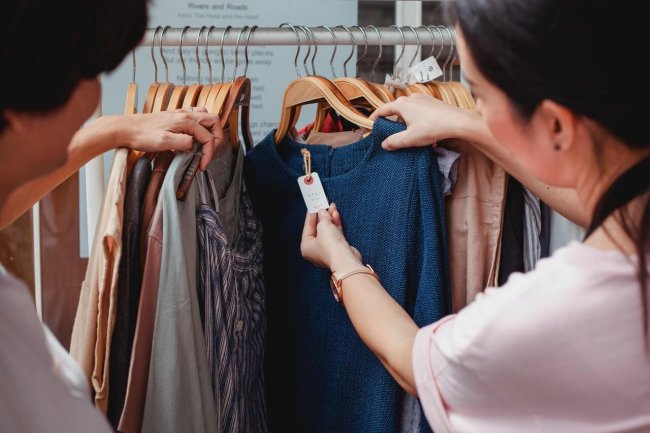
Of course the regulations have been slightly different depending on the country. For example, some states in the United States had regulations stating that stores were allowed only 50% of their maximum capacity whereas stores in the Netherlands were closed for three months at a time.
Unfortunately for these stores, the pandemic has only expedited the digital transformation of the retail industry and therefore, altered (dare I say permanently?) the shopping preferences of many consumers. Keep in mind – however- that many of the changes that took place as part of this transformation weren’t all detrimental…
Let’s take a closer look at some of the effects of the pandemic…
Effects on the Retail Industry
As previously mentioned, the pandemic has accelerated the shift to ecommerce everywhere.
Some major trends include:
1. Foot traffic (or in-store traffic) plummeting heavily:
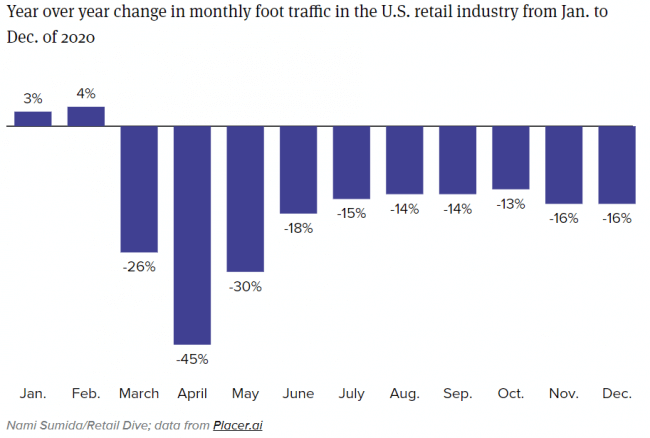
Source: Retaildive.com
2. However, Ecommerce sales went way up:
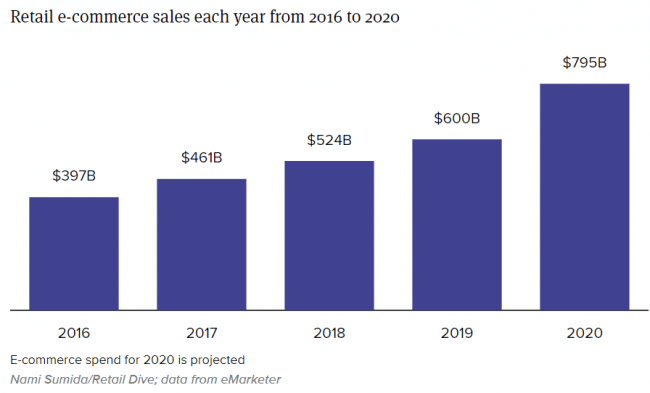
Source: Retaildive.com
3. And unfortunately, many bankruptcies started to stack up:
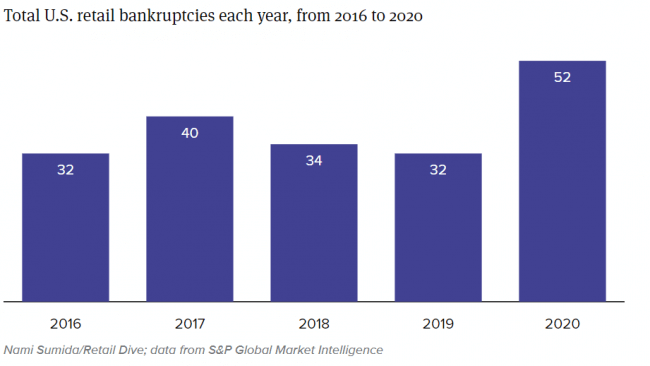
Source: Retaildive.com
And then of course, there was the potential that the pandemic brought on in more developing countries such as India, where online habits ranged anywhere from scarce to non-existing. To give you an idea, last year the ecommerce industry in India made up about 6.5% of the market. However thanks to the pandemic, retailers were shoved into the world of ecommerce, therefore accelerating the online ecosystem in these types of economies.
Here some other interesting effects the pandemic had on retailers:
- Accelerated the online ecosystem in some economies (i.e. India, Russia and Brazil)
- A significant boost in online customer experience
- More secure payment systems (especially in developing countries where cash was previously used in-stores)
- More efficient warehousing for fast shipping
Patricia Canavan, senior vice president of international and retail operations at Authentic Brands Group:
The online migration has been a silver lining of the COVID-19 era. One step it’s taken is working with local partners to speed up delivery by using warehouses closer to densely populated areas.
As you can see, this has thwarted us into a new way of working – with new digital strategies and a better eye for what the customer wants and needs. So what can we learn from these new trends?
Learnings from the Pandemic
Having developed habits of online shopping and delivery during this period, there’s little chance that these consumers will go back to their old ways. Learn how user feedback can aid in maintaining a sound customer experience.
That being said, retailers will be forced to employ a more innovative way of thinking and become more reactive. Simply replicating your in-store experience in an online environment won’t cut it. Our guess is that more retailers will likely start leveraging more transformative (and data-driven) technologies such as predictive analytics, AI-powered search, and personalisation. They will also need to become more in tune with their growing online customer base, monitoring the changing preferences and hurdles that these customers encounter on either their website or mobile app.
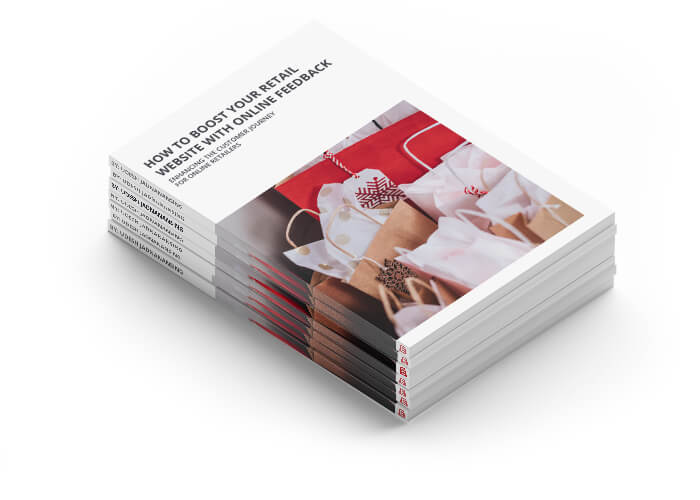
Free White Paper: Boost your retail website with online feedback
The latter presents an interesting challenge as it can be difficult to measure changing preferences and experiences without the right tools in place. Customer feedback is a great example of a tool that can provide you with meaningful insights into the online experience – especially within online retail funnels. From searching for products and showing up on search result pages, to the actual purchase of a product and after-sales service, you need to be there for your customer every step of the way. With a feedback solution you can gather feedback in moments that matter with feedback forms catered to your most critical touchpoints in the online shopping journey.

This is especially interesting for supporting customers who previously only ever purchased items in-store and aren’t familiar with online shopping. These visitors may need an adapted and further clarified customer journey that’s easy to follow and will help them achieve their online goals unhindered.
Collecting feedback from our online users is essential in order to identify all the main usability irritants and provide the appropriate solutions. We use feedback in our various E-merch, C.R.O and UX processes by targeting the key stages of the journey. This helps us collect very precise qualitative and declarative data which allows us to be much more efficient in improving the online journey.
Bastien Monet, E-Merchandising Leader, Decathlon
When it comes to the more logistical challenges such as online payment options and storage/shipping, we’re already seeing lots of retailers jumping into action. Whether that’s employing additional (and more secure) payment options such as Paypal or renting out local warehouses for speedier shipping, these organisations are quickly adapting.
The Future of Retail
With the pandemic still raging, companies will have little choice but to join the world of unified commerce. According to Business News Daily, it is likely that technology will continue to reshape the ecommerce landscape. We saw this happen when we started working from home and we’ll see it in the retail industry too. Emerging technologies such as those mentioned above will play a major role in the success of your business.
Also keep in mind that the growth of many markets and individual retail organisations has been extremely remarkable this past year, so it will be very interesting to see what 2021 and the future have in store for us.
Ready to see Mopinion in action?
Want to learn more about Mopinion’s all-in-1 user feedback platform? Don’t be shy and take our software for a spin! Do you prefer it a bit more personal? Just book a demo. One of our feedback pro’s will guide you through the software and answer any questions you may have.






